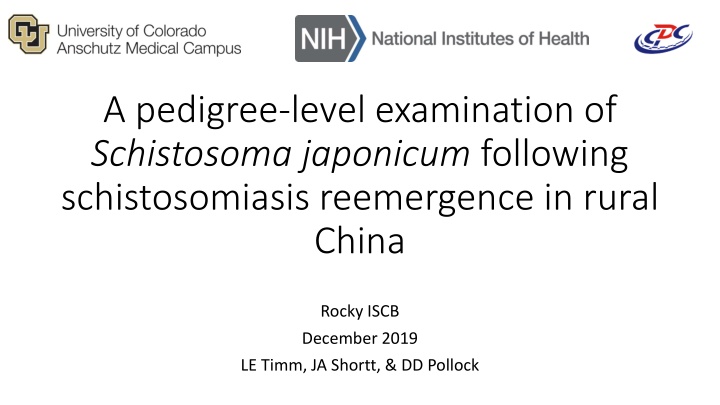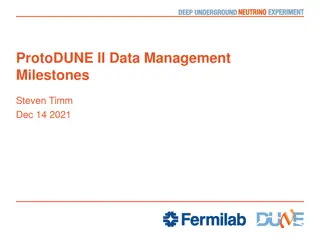
Examination of Schistosoma japonicum Reemergence in Rural China
Explore the reemergence of Schistosoma japonicum in rural China through a pedigree-level examination, identifying sources of new infections and genetic/geographic structures. Discover the mechanisms behind the persistence of infection and relatedness between Miracidia for a comprehensive understanding of the issue.
Download Presentation

Please find below an Image/Link to download the presentation.
The content on the website is provided AS IS for your information and personal use only. It may not be sold, licensed, or shared on other websites without obtaining consent from the author. If you encounter any issues during the download, it is possible that the publisher has removed the file from their server.
You are allowed to download the files provided on this website for personal or commercial use, subject to the condition that they are used lawfully. All files are the property of their respective owners.
The content on the website is provided AS IS for your information and personal use only. It may not be sold, licensed, or shared on other websites without obtaining consent from the author.
E N D
Presentation Transcript
A pedigree-level examination of Schistosoma japonicum following schistosomiasis reemergence in rural China Rocky ISCB December 2019 LE Timm, JA Shortt, & DD Pollock
Acknowledgments Sichuan Center for Disease Control & Prevention Pollock Lab Yang Liu David Pollock Bo Zhong Jonathan Shortt Sequencing Todd Castoe Epidemiology Drew Schield Beth Carlton Nicky Hales Andrea Buchwald Zachary Nikolakis
Schistosoma & Schistosomiasis A mating pair can produce hundreds of thousands of fertilized eggs per day FZ Hapan
Re-emergence of Schistosomiasis in Sichuan Province, China 1950s: Schistosomiasis control programs introduced mollusciciding & mass administration of praziquantel 2000s: recorded infections had declined 99% However, several regions experience No further declines Increasing infection rates Why does infection persist?
Data Generation Whole genome amplification + ddRADseq 33,901 SNPs across 200 individuals
Genetic and Geographic Structure Easternmost village 0.3 0.2 0.1 Westernmost village PC2 5.1% 0.0 Northernmost village 0.1 0.2 0.3 Southernmost village 0.0 0.1 0.2 0.2 0.1 PC1 8.08%
Why does infection persist? Local sources of infection are implicated (as opposed to inter-village transport) By what mechanism?
Inferring Relatedness between Miracidia 0.6 Unrelated BetweenVillages 0.5 WithinVillageBetweenHosts 4th degree relatives (first cousins) WithinHost Probability Density 0.4 0.3 3rd degree relatives 0.2 2nd degree relatives (siblings) 0.1 0 0 0.1 0.2 0.3 0.4 0.5 Rare Allele Sharing
Meta-relationships 16027C 16027B 16027D Host1 16027A 16027E Same village Same collection event (December 2010) 16030A 16030E Host2 16030B Posterior probabilities of 1st degree relationships (siblings)
Meta-relationships 16027C Posterior probabilities of 2nd degree relationships 1) double first cousins 2) half-siblings 3) aunt/uncle-niece/nephew 16027B 16027D 16027A 16027E 16030A 16030E 16030B
Double first cousins Evidence of a very small population and a lot of inbreeding
Half-siblings Evidence of a high degree of clonality
Aunt/uncle-niece/nephew (piblings) Evidence of a direct human-snail-human transmission
Moving Forward Sample from non-human mammals Identify any additional examples of meta-relatedness Develop a means of differentiating between the types of relatedness (double first cousins vs half-siblings vs piblings)
Towards Differentiation Extend haplotypes -> capable of rapidly pulling clusters of sites in linkage disequilibrium (microhaplotypes) Simulate recombination -> generate pedigrees including all relationships of interest Identify expected patterns of allele sharing for different relationships Providing unprecedented insight into disease transmission at the individual parasite level
**** **** 0.8 **** 0.6 MAFA 0.4 Genetic and Geographic Structure Rare Allele Sharing Proportion 0.2 0.2 0.0 0.1 (10,20] bin (20,30] ( 1,10] 1-10km 10-20km 20-30km Inter-Village Distance

